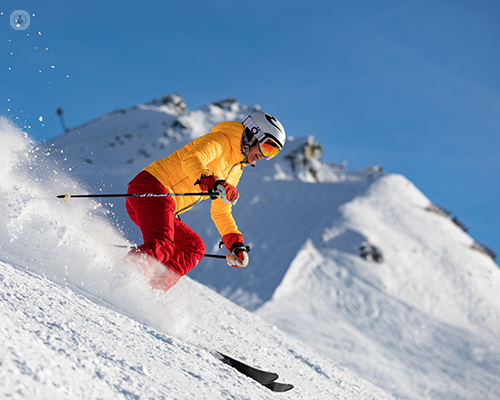Understanding types and causes of snow sports injuries
Written by:Fans of snow sports are susceptible to a variety of injuries while participating in skiing and snowboarding, including hip and knee injuries. Learn from Mr Sudhir Rao, a consultant trauma and orthopaedic surgeon who is highly experienced in sports-related injuries, about the potential injuries that you could have while participating in snow sports.

Are snow sports safe?
One in every 1,000 skiers suffers injuries per season. In the winter sports season, GPs, physiotherapists and doctors in urgent care centres (UCC) need to be aware how important it is to accurately diagnose these injuries to prevent long term disability and damage to the joint if they are not correctly treated.
Data from America’s National Ski Areas Association for the 2011-12 season showed that the fatality rate was 1.06 per million skier days, with only 0.001% of visitors suffering a major injury in the total days of participation during that season. More evidence from Scotland indicates that you would have to ski or snowboard for 447 days on average before you would sustain an injury.
So when you consider this, snow sports are a relatively safe pursuit compared to other sports. You get a better understanding of the risks when the reason for accidents is broken down. Unfortunately, young men get just as bad a reputation on the slopes as they do on the roads: 85% of fatalities in the US are males and 70% are aged from late teens to late 30s.
|
Average distribution of injuries |
|
|
Head |
17% |
|
Upper extremities |
29% |
|
Body |
12% |
|
Lower extremities |
42% |
|
Shoulder |
10% |
|
Skiers thumb |
7% |
|
Knee |
23% |
Despite accounting for a relatively small fraction of all injuries, head injuries are particularly serious given that they are the most frequent cause of death and severe disability – for example, Michael Schumacher had a head injury and is still recovering.
In another study, “Injuries in Recreational Adult Fitness Activities” , which was published in the American Journal of Sports Medicine in 1993, they compared the rate of skiing injury per 1000 hours with other sports. The rate for skiing was 8, which is higher than tennis (5) but lower than running (11), squash (14) and rugby (30).
Snowboarding carries a greater risk of injury than skiing. According to ski-injury.com, the rate of injury for boarders is at 5.31 per 1000 snowboarding days – that’s about double the injury rate for skiers.
Lower limb injuries
Better equipment has resulted in fewer fractures but knee injuries still occur quite often. About half of lower limb injuries occur in the knee.
Knee injuries
ACL (anterior cruciate ligament) injuries in combination with MCL (medial collateral ligament) injuries and associated medial or lateral meniscus tears are the most common types of injuries, along with bone bruising. Very often, this occurs as the skis do not come off when the skier falls when the knee twists or when the skis get stuck in the snow. Often, X-ray results appear normal but the key diagnostic tool is an MRI scan - this will show the full extent of the injury. At the BMI and Lycahealth centres, we have excellent imaging facilities to pick up this injury.
Key features of knee injuries
- Immediate swelling (blood) in the knee
- Inability to walk or ski
- Feeling something “pop” in the knee
- Feeling of instability
- Pain in the swollen knee
Many knee injuries need specialist assessment and treatment to avoid long-term problems with knee function. Physiotherapy to help get the knee mobile and settled, followed by ACL reconstructive surgery if required.
Fractures
Tibial fractures, femoral fractures and intra-articular knee fractures are relatively rare now due to modern equipment. These can usually be diagnosed with a plain x-ray which is often done in the local medical centre.
Upper limb injuries
There are several ways skiers and snowboarders can injure their upper body.
Shoulder injuries
About a third to half of upper limb injuries occurs in the shoulder region. Shoulder and clavicle (also called AC joint) injuries are more common in snowboarders than in skiers. In both skiers and snowboarders, it is common to have injuries from a direct blow to the shoulder or while stopping a fall. Clavicle fractures/AC joint dislocations are more common in younger patients and fractures in middle-aged and elderly skiers. Most require specialist assessment by X-rays and/or MRI scans to ensure these injuries are managed properly.
Wrist
These injuries are much more frequent in snowboarders trying to stop a fall. The injuries can be quite severe and need specialist assessment and management.
Thumb
The most common injury is due to the ski-pole and wrist strap trapping the thumb and twisting it. The injury typically is a tear of the ulnar collateral ligament of the thumb MCP (metacarpophalangeal) joint which needs to be assessed by X-ray and/or MRI scan. If the ligament injury is severe, surgery may be required. In minor injuries, splinting for six weeks may suffice.
Now that you understand snow sports-related injuries, learn how to prevent them by taking a look at Mr Rao’s other article, ‘preventing snow sports injuries’.
Click here to view Mr Rao’s Top Doctors profile.



